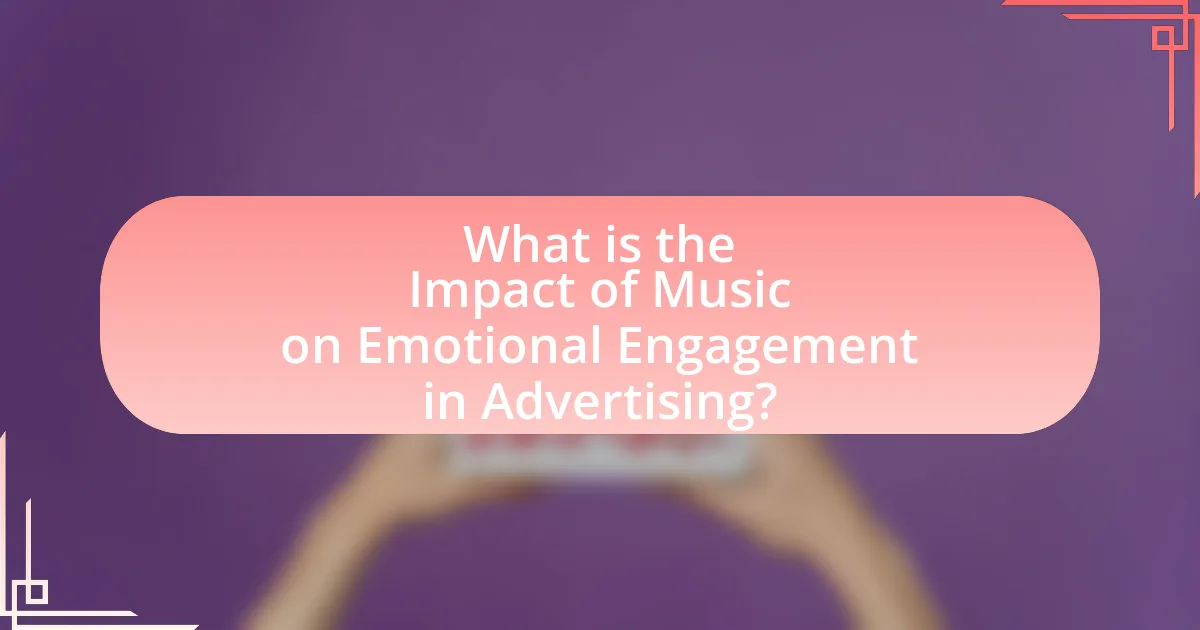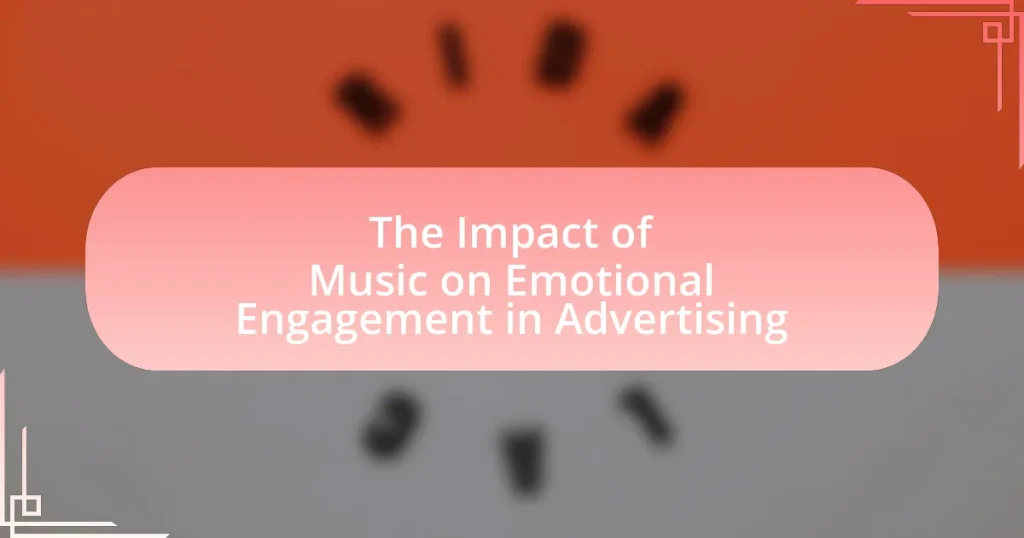The article examines the impact of music on emotional engagement in advertising, highlighting how music enhances consumer emotions, brand recall, and purchasing behavior. It discusses the psychological mechanisms through which music influences emotions, including emotional contagion and memory association, and explores how different musical elements and genres affect emotional responses. The importance of emotional engagement in advertising is emphasized, noting its role in consumer decision-making and brand loyalty. Additionally, the article outlines best practices for selecting music in advertising, challenges faced in integration, and methods for measuring effectiveness, while cautioning against common mistakes in music selection.

What is the Impact of Music on Emotional Engagement in Advertising?
Music significantly enhances emotional engagement in advertising by evoking specific feelings and memories that resonate with consumers. Research indicates that music can influence mood, increase brand recall, and enhance the overall effectiveness of advertisements. For instance, a study published in the Journal of Advertising Research found that ads featuring congruent music led to a 96% increase in emotional response compared to those without music. This emotional connection fosters a stronger bond between the consumer and the brand, ultimately driving purchasing behavior.
How does music influence consumer emotions in advertisements?
Music significantly influences consumer emotions in advertisements by evoking specific feelings that enhance brand perception and recall. Research indicates that background music can alter mood and create emotional connections, leading to increased engagement with the advertisement. For instance, a study published in the Journal of Consumer Research found that upbeat music can elevate positive emotions, making consumers more likely to respond favorably to the product being advertised. Additionally, music that aligns with the brand’s message can reinforce emotional responses, thereby improving the likelihood of purchase intent.
What psychological mechanisms are involved in music’s effect on emotions?
Music influences emotions through several psychological mechanisms, including emotional contagion, memory association, and physiological arousal. Emotional contagion occurs when listeners mimic the emotions expressed in music, leading to a shared emotional experience. Research indicates that music can evoke specific emotions by triggering memories associated with past experiences, as demonstrated in studies showing that familiar songs can elicit strong emotional responses due to their connection to personal memories. Additionally, music can induce physiological arousal, such as changes in heart rate and skin conductance, which further enhances emotional experiences. These mechanisms collectively explain how music effectively engages emotions in contexts like advertising, where emotional resonance can significantly impact consumer behavior.
How do different musical elements affect emotional responses?
Different musical elements significantly influence emotional responses by evoking specific feelings through melody, harmony, rhythm, and dynamics. For instance, major keys often elicit happiness, while minor keys can evoke sadness, as demonstrated in studies showing that listeners associate major chords with positive emotions and minor chords with negative emotions. Additionally, tempo affects emotional intensity; faster tempos can create excitement or urgency, while slower tempos may induce calmness or reflection. Research by Bruner (1990) indicates that music with a strong beat can enhance feelings of joy and energy, making it effective in advertising to engage consumers emotionally. Thus, the interplay of these musical elements shapes how audiences perceive and react to messages in advertising contexts.
Why is emotional engagement important in advertising?
Emotional engagement is important in advertising because it significantly influences consumer behavior and brand loyalty. When advertisements evoke emotions, they create a deeper connection with the audience, leading to increased recall and preference for the brand. Research indicates that emotionally charged advertisements can lead to a 23% increase in sales compared to those that do not engage emotions. This is supported by a study from the Nielsen Company, which found that ads with emotional appeal outperform those with purely rational messages in terms of effectiveness. Thus, emotional engagement is a critical factor in driving consumer decisions and enhancing brand relationships.
What role does emotional engagement play in consumer decision-making?
Emotional engagement significantly influences consumer decision-making by shaping preferences and driving purchasing behavior. When consumers feel emotionally connected to a brand or product, they are more likely to develop loyalty and make repeat purchases. Research indicates that emotionally engaged consumers are 52% more valuable than those who are merely satisfied, as they tend to spend more and advocate for the brand. This connection is often facilitated by advertising strategies, such as the use of music, which can evoke specific emotions and enhance the overall consumer experience. For instance, a study published in the Journal of Advertising Research found that advertisements featuring emotionally resonant music increased brand recall and purchase intent, demonstrating the powerful role of emotional engagement in guiding consumer choices.
How does emotional engagement enhance brand recall and loyalty?
Emotional engagement significantly enhances brand recall and loyalty by creating strong, memorable connections between consumers and brands. When consumers experience emotions through advertising, such as joy or nostalgia, they are more likely to remember the brand associated with those feelings. Research indicates that emotionally charged advertisements can increase brand recall by up to 23% compared to neutral ads. This heightened recall leads to increased loyalty, as consumers are more inclined to choose brands that resonate with them emotionally. A study by the Nielsen Company found that ads with emotional content performed about twice as well as those with only rational content in terms of brand recall and purchase intent.
What types of music are most effective in advertising?
Upbeat and familiar music types are most effective in advertising. Research indicates that music with a fast tempo and positive connotations enhances consumer engagement and brand recall. For instance, a study published in the Journal of Advertising Research found that advertisements featuring upbeat music led to a 20% increase in brand recognition compared to those with neutral or slow music. Additionally, familiar tunes can evoke nostalgia, further strengthening emotional connections with the brand. This combination of tempo and familiarity creates a more memorable advertising experience, ultimately driving consumer behavior.
How do different genres of music impact emotional engagement?
Different genres of music significantly impact emotional engagement by evoking distinct emotional responses and influencing consumer behavior. For instance, studies show that upbeat genres like pop and dance music can enhance feelings of happiness and excitement, leading to increased engagement with advertisements. Conversely, genres such as classical music often evoke feelings of calmness and nostalgia, which can create a more reflective emotional state in the audience. Research published in the Journal of Consumer Research indicates that the congruence between the music genre and the advertisement’s message enhances emotional resonance, thereby improving brand recall and purchase intent. This demonstrates that the choice of music genre is crucial in shaping emotional engagement in advertising contexts.
What factors determine the appropriateness of music in specific advertisements?
The appropriateness of music in specific advertisements is determined by factors such as target audience, brand identity, emotional tone, and cultural context. Target audience influences music selection, as different demographics respond to various genres and styles; for example, younger audiences may prefer contemporary pop, while older demographics might resonate more with classic rock. Brand identity requires that the music aligns with the values and image of the brand, ensuring consistency in messaging; for instance, a luxury brand may choose classical music to evoke sophistication. Emotional tone is critical, as music can enhance the intended emotional response; studies show that upbeat music can create feelings of happiness, while slower tempos may evoke nostalgia or sadness. Cultural context also plays a significant role, as music that is culturally relevant can enhance relatability and connection with the audience; for example, using local music styles can foster a sense of community. These factors collectively ensure that the music used in advertisements effectively engages the audience and reinforces the overall message.
How can advertisers effectively use music to enhance emotional engagement?
Advertisers can effectively use music to enhance emotional engagement by selecting tracks that align with the emotional tone of their message. Research indicates that music can evoke specific emotions, influencing consumer perceptions and behaviors; for instance, a study published in the Journal of Consumer Research found that background music can significantly affect mood and purchasing decisions. By carefully choosing music that resonates with the target audience’s feelings, advertisers can create a stronger connection, making the advertisement more memorable and impactful.
What are the challenges of integrating music into advertising campaigns?
Integrating music into advertising campaigns presents several challenges, including copyright issues, audience perception, and alignment with brand messaging. Copyright issues arise when advertisers must secure licenses for music, which can be costly and time-consuming; for instance, using popular songs often requires negotiations with multiple rights holders. Audience perception is another challenge, as the effectiveness of music can vary widely among different demographics, making it difficult to select tracks that resonate universally. Additionally, ensuring that the chosen music aligns with the brand’s messaging and values is crucial; mismatched music can lead to confusion or negative associations, undermining the campaign’s effectiveness. These challenges necessitate careful planning and consideration to successfully integrate music into advertising.
What best practices should advertisers follow when selecting music for emotional engagement?
Advertisers should select music that aligns with the emotional tone of their message to enhance emotional engagement. This involves choosing melodies and harmonies that evoke the desired feelings, such as happiness, nostalgia, or excitement. Research indicates that music can significantly influence consumer emotions and decision-making; for instance, a study published in the Journal of Consumer Research found that congruent music can increase brand recall and positive attitudes towards advertisements. Additionally, advertisers should consider the tempo and volume of the music, as faster tempos can create excitement while slower tempos can evoke calmness. By ensuring that the selected music complements the visual and narrative elements of the advertisement, advertisers can create a cohesive emotional experience that resonates with the audience.
How can advertisers measure the effectiveness of music in their campaigns?
Advertisers can measure the effectiveness of music in their campaigns through various metrics such as brand recall, emotional response, and sales conversion rates. Research indicates that music can significantly enhance emotional engagement, leading to improved brand recall; for instance, a study by Bruner (1990) found that background music can influence consumer behavior and memory retention. Additionally, advertisers can utilize tools like biometric measurements (e.g., heart rate, skin conductance) to assess emotional responses elicited by music in advertisements. A study published in the Journal of Advertising Research demonstrated that ads with congruent music led to higher emotional engagement and purchase intent compared to those without. By analyzing these metrics, advertisers can effectively gauge the impact of music on their campaign’s success.
What common mistakes should be avoided when using music in advertising?
Common mistakes to avoid when using music in advertising include selecting music that does not align with the brand message, using overly complex compositions that distract from the advertisement, and failing to consider the target audience’s preferences. Misalignment between music and brand can lead to confusion about the product’s identity, as evidenced by studies showing that congruent music enhances brand recall. Overly complex music can detract from the message, as research indicates that simpler melodies are more memorable and effective in advertising contexts. Additionally, ignoring audience preferences can result in disengagement, as surveys reveal that music tailored to demographic tastes significantly boosts emotional connection and response rates.


